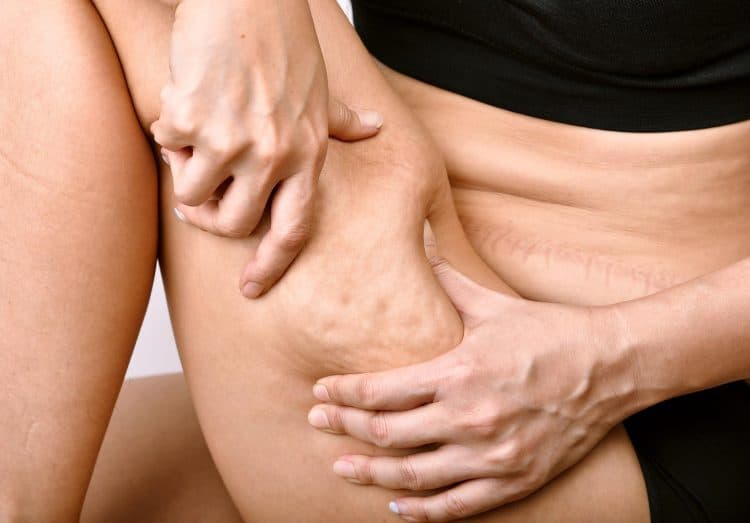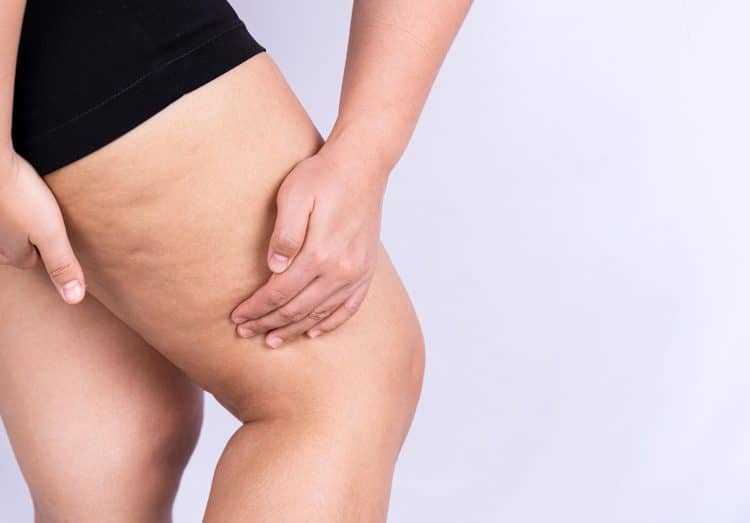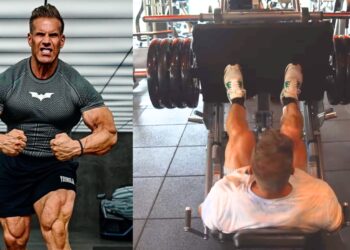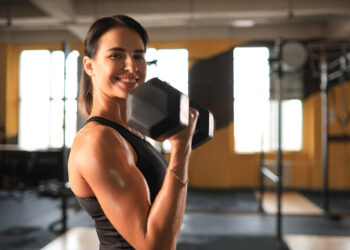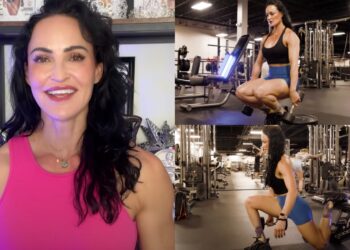Many people struggle with weight gain. Stress and anxiety from the now-prevalent work-from-home culture, COVID, and the crazy fluctuations in Dogecoin prices add to the problem.
An individual doesn’t gain weight evenly in the accumulation phase. Most people, especially women, gain body weight in a particular pattern. The fat build-up usually starts in the lower abdomen. Initially, it might look like you’re transitioning into a pear-shaped body (thighs and hips are wider than your bust and waistline), but rest assured, you’ll move towards a diamond, square, or rectangle figure if you don’t fix the underlying issues.
Next, the extra fat trickles into their legs, especially the thighs, then shows its sign on the face, chest, and arms. While there are exceptions to this pattern, it stands true for the majority.
Now, don’t get us wrong. We aren’t here for body-shaming. Every individual is beautiful in their own way. Plus, thanks to the Kardashians, an hourglass figure has become a popular physique goal for many women. If you didn’t already know, it is easier to go from a pear-shaped body to an hourglass figure than to look like Kim K starting from a carrot-type body.
The most common issue with a heavier rear is the extra fat around the thighs. This article will elaborate on how you can lose thigh fat, the time this process might take, making the right food choices, and how to keep body fat at bay.
What Causes Thigh Fat?
Level Up Your Fitness: Join our 💪 strong community in Fitness Volt Newsletter. Get daily inspiration, expert-backed workouts, nutrition tips, the latest in strength sports, and the support you need to reach your goals. Subscribe for free!
Thigh fat is caused by a combination of a calorie surplus diet, eating junk food, a sedentary lifestyle, and genetics. It is also influenced by an individual’s age, gender, ethnic origin, and recent weight gain.
Women are more prone to inner thigh fat than men because of the hormones progesterone and estrogen. On the other hand, an individual’s metabolic rate drops with age, slowing the rate at which their body burns fat and spiking their stored body fat percentage.
A bodyweight spurt can also cause a thigh fat build-up. If you are planning to gain weight, you should do so in a planned and controlled environment. Gulping down a box of donuts with a cold coffee increases the chances of building up fat in your upper legs.
How To Lose Thigh Fat?
Before we get into the nitty-gritty of losing thigh fat, let’s address the elephant in the room. Spot reduction doesn’t work. Please do not burn your hard-earned money on spot-reduction fads like sauna belts or unproven gels.
1. Follow a Calorie-Deficit Diet
A calorie deficit refers to eating fewer calories than you burn in a day. However, many people go overboard with this as they try to lose too much weight too soon.
If you go too hard on the calorie deficit, your body will enter a catabolic stage, meaning it will break down muscle to use as fuel. You’ll also be short of energy throughout the day.
Do not make the mistake of following a generic calorie-deficit program. It should be designed as per your lifestyle. Here is how to make a personalized calorie deficit diet:
- Determine your average daily caloric intake.
- Per a 2012 study, reducing 500 to 1,000 kilocalories (kcal) per day from your diet should result in a weight loss of one to two pounds per week. [1]
- Cutting out more than 1,000 calories a day from your diet can hamper your functioning and weaken your immune system. Plus, on such a harsh deficit, the weight is more prone to bounce back as soon as you revert to your original diet.
Food Choices
Your food choices play a big role in your physique aesthetics. Get rid of all the greasy, high-calorie, unhealthy foods from your diet and replace them with nutrient-dense whole foods.
Here are some food options that should be a staple in your diet:
Carbohydrates:
- vegetables
- quinoa
- barley
- legumes
- potatoes
- whole grains
- oats
- beans
- rice
Protein:
- eggs
- chicken breast
- Greek yogurt
- cottage cheese
- milk
- lentils
- fish
- quinoa
- whey protein
Fat:
- fatty fish
- chia seeds
- dark chocolate
- eggs yellow
- avocado
- flaxseed
- nuts
- Nut and seed butter
2. Exercise
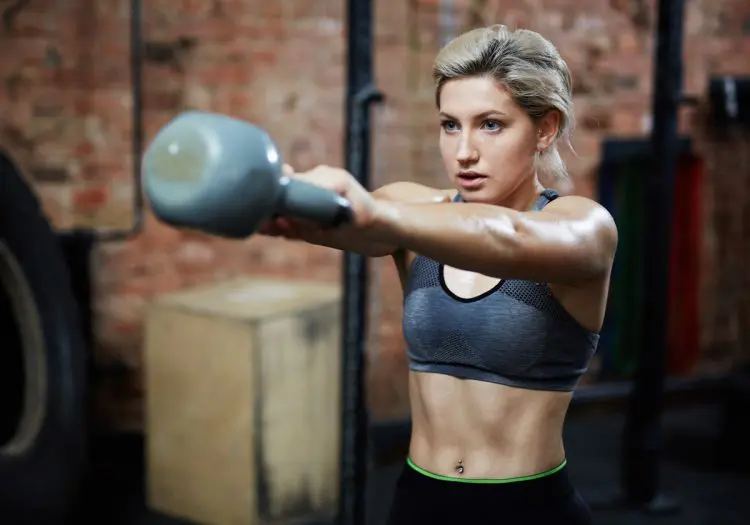
Besides nailing your diet, following an effective HIIT cardio and strength training regimen can help speed up your thigh fat loss process.
HIIT (high-intensity interval training) helps build strength, burn fat, and revs up your metabolism. HIIT training includes switching between high, often explosive-intensity, bouts with recovery-intensity bouts. For instance, on a HIIT cardio routine, you’ll sprint all-out for a minute and then slow down for the next minute. You’ll repeat this cycle until you complete 10 minutes.
HIIT resistance training includes high volume and intensity workouts with minimal rest between sets. If a normal intensity workout takes you an hour to complete, try finishing it within 45 minutes on a HIIT routine, but without compromising on the volume, intensity, or form.
Furthermore, you should ideally perform two cardio sessions a day to lose thigh fat. The first should be a 10-minute HIIT cardio done after a HIIT resistance training workout. Doing it before a workout can sacrifice your performance in the weight training session. Hence, saving it for later is recommended.
The second cardio session will be LISS (low-intensity steady-state), which includes performing a cardiovascular activity of your choice at low-to-moderate intensity for 30-45 minutes every day first thing in the morning on an empty stomach.
3. Regulate Your Salt Intake
Excess sodium intake can make you hold water, and people dealing with excess thigh fat generally retain this water on the back of their thighs. Plus, you might notice bloating while going overboard with NaCl.
However, do not cut out salt from your diet completely. It plays important roles in your body like balancing electrolytes and preventing muscle cramps, keeping you hydrated, supporting a healthy nervous system, promoting vascular health, and improving sleep. The WHO suggests consuming 2,000 mg (2 grams) of sodium per day, and the American Heart Association advises a much lower intake of 1,500 mg (1.5 grams) per day. [2][3]
Factors To Consider For Losing Thigh Fat
Things to consider in a fat loss program include:
1. Genetics
As much as we hate to admit it, genetics play a crucial role in how our body responds to certain stimuli. Most of us have a friend who can down a cheesecake without worrying about his weight. On the other hand, some people can gain weight just by sniffing an ice cream.
Furthermore, every individual deals with fat gain differently. While some folks begin storing fat in the thighs, others might not see a fat build-up in their lower bodies even if they gain 20 pounds in a month.
On top of that, there is the issue of cellulite. Cellulite is most prevalent in women and can cause lumpy, dimpled flesh on the thighs, hips, buttocks, and abdomen.
2. Lifestyle
It’s no secret your lifestyle plays an important role in determining your fitness levels. Here are a few lifestyle parameters to consider:
a. Activity Level
If you have a desk job, your likelihood of gaining thigh fat increases. On the other hand, an active individual will burn calories throughout the day due to a high metabolic rate.
Level Up Your Fitness: Join our 💪 strong community in Fitness Volt Newsletter. Get daily inspiration, expert-backed workouts, nutrition tips, the latest in strength sports, and the support you need to reach your goals. Subscribe for free!
b. Stress and Anxiety
High-stress levels and anxiety can shoot up your cortisol levels. Cortisol is popularly known as the stress hormone and is produced in the adrenal glands found just above your kidneys.
A study found an association between higher cortisol response and a higher amount of belly fat in a group of 172 men and women, suggesting that higher cortisol may lead to overeating, which could potentially promote weight gain. [4]
Plus, a 2017 study found that participants with higher baseline stress levels gained more weight over six months than those with lower stress levels. [5]
c. Alcohol
On a time-bound fat loss program, you should completely cut alcohol from your routine as it contains empty calories, meaning it is high in calories but provides no nutritional value.
Furthermore, binge drinking can lead to poor dietary choices and overeating, which can set you back on your transformation journey.
Must Read: How To Drink Alcohol Without Losing Muscle and Gaining Fat
d. Sleep
Sleep and recovery are amongst the most overlooked subjects in a physique transformation program. It doesn’t matter how hard you train or diet; you won’t see the desired results until you give your body enough time to rest and recuperate from your workouts.
Sleep regulates various bodily hormones. The hormones leptin and ghrelin help regulate appetite and are affected by a lack of sleep. Sleep deprivation can spike your cravings and make you binge eat junk food.
Aim for seven to eight hours of sleep every night for optimal recovery and ensure balanced hormones.
Best Exercises To Lose Thigh Fat
The infamous thigh fat is located at your inner thighs and hamstrings so we’ll focus on exercises that primarily target these areas. Although strength exercises do not directly help lose thigh fat, they help tone, strengthen, and stimulate the underlying muscles.
Given below are some thigh fat shedding exercises that should be a part of your exercise arsenal:
1. Sumo squat
How to perform:
- Stand with your feet shoulder-width apart and your toes pointing out.
- Grab a dumbbell with both hands and hold it in front of your body.
- While keeping your core tight and torso upright, lower yourself into a squat by pushing your hips back and down.
- Go as low as possible and pause at the bottom.
- Return to the starting position explosively while pushing through your heels.
Pro Tips:
- Pointing your toes towards 10 and 2 o’clock focuses on your inner thighs.
- A little forward bend while performing this exercise is normal. However, make sure your lower back does not take over the movement.
- Target Muscle Group: Quads
- Secondary Muscles: Calves, Glutes, Hamstrings, Lower Back
- Type: Hypertrophy
- Mechanics: Compound
- Equipment: Dumbbell
- Difficulty: Beginner to Advanced
- Best Rep Range:
- Hypertrophy: 12-15 reps
- Strength: 2-5 reps
- Progression: Deficit sumo squat
Check out the complete sumo squat guide here!
2. Curtsy lunge
How to perform:
- Stand upright with a shoulder-wide stance with your hands in front of your chest.
- Step back across your body at a 45-degree angle.
- Lower until your back knee touches the floor.
- Push off the front leg and return to the starting position.
- Alternate between sides for recommended reps.
Pro Tips:
- Do not take a giant step back as it can throw you off balance.
- Try keeping your upper body as upright as possible throughout the movement.
- Target Muscle Group: Glutes
- Secondary Muscles: Abductors, Hamstrings, Hip Flexors, Quads
- Type: Hypertrophy
- Mechanics: Compound
- Equipment: Bodyweight
- Difficulty: Beginner
- Best Rep Range:
- Hypertrophy: 12-15 reps
- Progression: Weighted Curtsy lunge
3. Lateral lunge
How to perform:
- Get into the starting position with your feet shoulder-width apart.
- Step to your side with your trail leg extended and descend until the front thigh is parallel with the floor.
- Drive through the front leg and extend the knee as you push back to the starting position.
- Alternate between sides for recommended reps.
Pro Tips:
- Warm up your hips adequately before attempting this exercise.
- People with limited hip mobility and core strength might struggle with this exercise.
- Target Muscle Group: Quads
- Secondary Muscles: Abs, Adductors, Calves, Glutes, Hamstrings, Upper Back
- Type: Hypertrophy
- Mechanics: Compound
- Equipment: Bodyweight
- Difficulty: Beginner
- Best Rep Range:
- Hypertrophy: 12-15 reps
- Progression: Barbell lateral lunge
4. Goblet squat
How to perform:
- Stand upright with a shoulder-wide stance and hold a dumbbell in front of your chest.
- Descend into a squat by pushing your hips back and down while maintaining an upright torso.
- Go as deep as possible.
- Drive through your heels to return to the starting position.
Pro Tips:
- Warm up your forearms and wrists before getting into the working sets.
- Elevating your heels by standing on a weight plate can improve your range of motion while performing squats, especially if you have a stiff lower back or legs.
- Target Muscle Group: Quads
- Secondary Muscles: Abs, Adductors, Calves, Glutes, Hamstrings, Lower Back
- Type: Hypertrophy
- Mechanics: Compound
- Equipment: Dumbbell
- Difficulty: Beginner
- Best Rep Range:
- Hypertrophy: 12-15 reps
- Progression: Double kettlebell front squat
Check out the complete goblet squat guide here!
5. Clamshell
How to perform:
- Lie on your side with your legs stacked and knees bent at a 45-degree angle.
- Rest your head on your lower arm, and use your top arm to steady your frame.
- Tighten your core, as this will help stabilize your spine and pelvis.
- Keeping your feet touching, raise your upper knee as high as possible without shifting your hips or pelvis.
- Make sure your lower leg is always on the floor.
- Pause and contract your glutes at the top.
- Return to the starting position.
- Repeat for reps.
Pro Tips:
- If the bodyweight variation of this exercise feels too easy, use a resistance band for additional tension.
- Keep your head in a comfortable position to avoid straining your neck.
- Target Muscle Group: Glutes
- Secondary Muscles: Abs, Abductors, Quads
- Type: Hypertrophy
- Mechanics: Compound
- Equipment: Bodyweight
- Difficulty: Beginner
- Best Rep Range:
- Hypertrophy: 12-15 reps
- Progression: Weighted hip abduction
6. Glute kickback
How to perform:
- Get into a tabletop position with your hands under your shoulders and your knees under your hips.
- While maintaining a neutral spine and a 90-degree angle at the knee, extend the hip and lift your foot towards the ceiling.
- Slowly return to the starting position.
- Repeat for recommended repetitions before switching sides.
Pro Tips:
- You could also perform this exercise using a Smith machine or leg extension machine for added resistance.
- Drive through your heel while raising your working leg towards the ceiling.
- Target Muscle Group: Glutes
- Secondary Muscles: Hamstrings
- Type: Hypertrophy
- Mechanics: Isolation
- Equipment: Bodyweight
- Difficulty: Beginner
- Best Rep Range:
- Hypertrophy: 12-15 reps
- Progression: Resistance band glute kickback
Check out the complete glute kickback guide here!
7. Hip thrust
How to perform:
- Place your back against a flat bench and your feet flat on the floor at shoulder-width apart.
- Position a barbell on your hip crease.
- Drive both feet into the floor and squeeze your glutes while bridging lifting your hips towards the ceiling.
- Pause and contract your glutes at the top.
- Lower your hips back to the starting position and repeat for the desired number of repetitions.
Pro Tips:
- Use a weight you can hold at the top for a second.
- Your body should be in a straight line from your knees through your shoulders at the peak of the contraction.
- Target Muscle Group: Glutes
- Secondary Muscles: Hamstrings, Abs
- Type: Hypertrophy
- Mechanics: Isolation
- Equipment: Bodyweight
- Difficulty: Intermediate
- Best Rep Range:
- Hypertrophy: 12-15 reps
- Progression: Resistance band glute kickback
Check out the complete hip thrust guide here!
On the other hand, if you are not a fan of hitting the gym or performing resistance or bodyweight exercises, you can engage in the following activities:
Thigh Fat-Busting Leg Workout
Use the following workouts to target your thigh fat:
Workout 1
| Exercise | Sets | Reps |
| Running | 10 minutes (HIIT cardio) | |
| Goblet squat | 3 sets | 12-15 reps |
| Lateral lunge | 3 sets | 12-15 reps |
| Barbell thrust | 3 sets | 12-15 reps |
| GHD raise | 3 sets | 12-15 reps |
| Donkey kick | 3 sets | 12-15 reps |
Workout 2
| Exercise | Sets | Reps |
| Stairmaster | 10 minutes (HIIT cardio) | |
| Sumo squat | 3 sets | 12-15 reps |
| Curtsy lunge | 3 sets | 12-15 reps |
| Clamshell | 3 sets | 12-15 reps |
| Cable pull-through | 3 sets | 12-15 reps |
| Romanian deadlift | 3 sets | 12-15 reps |
FAQs
Does swimming, cycling, or walking reduce body fat?
Weight and body fat loss are results of burning more calories than you consume in a day. Swimming, cycling, and walking can help shed body fat when combined with a calorie deficit routine.
Can I lose thigh fat without exercise?
Yes, you could burn thigh fat without exercise. However, exercises like the ones mentioned above help stimulate your muscles and can help boost your fat loss progress.
How long does it take to lose thigh fat?
It depends on your goal and your current body fat percentage. You should expect positive results within 8-12 weeks while following a calorie deficit diet and an effective training program.
Wrapping Up
Now that you know everything you need to know about losing thigh fat, it’s time to make a personalized program and put it into action.
Thigh fat can be stubborn and might need a lot of hard work, patience, and persistence before you start noticing results. Trust the process and stick to your program for at least 8-12 weeks before expecting results.
References
- Champagne CM, Broyles ST, Moran LD, Cash KC, Levy EJ, Lin PH, Batch BC, Lien LF, Funk KL, Dalcin A, Loria C, Myers VH. Dietary intakes associated with successful weight loss and maintenance during the Weight Loss Maintenance trial. J Am Diet Assoc. 2011 Dec;111(12):1826-35. doi: 10.1016/j.jada.2011.09.014. PMID: 22117658; PMCID: PMC3225890.
- Sodium Intake for Adults and Children. Geneva: World Health Organization; 2012.
- Steptoe A, Kunz-Ebrecht SR, Brydon L, Wardle J. Central adiposity and cortisol responses to waking in middle-aged men and women. Int J Obes Relat Metab Disord. 2004 Sep;28(9):1168-73. doi: 10.1038/sj.ijo.0802715. PMID: 15211363.
- Chao, A.M., Jastreboff, A.M., White, M.A., Grilo, C.M. and Sinha, R. (2017), Stress, cortisol, and other appetite-related hormones: Prospective prediction of 6-month changes in food cravings and weight. Obesity, 25: 713-720.

